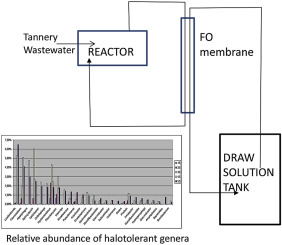Water Research ( IF 12.8 ) Pub Date : 2018-05-25 , DOI: 10.1016/j.watres.2018.05.046 M.J. Luján-Facundo , J. Fernández-Navarro , J.L. Alonso-Molina , I. Amorós-Muñoz , Y. Moreno , J.A. Mendoza-Roca , L. Pastor-Alcañiz

|
Tannery wastewaters are difficult to treat biologically due to the high salinity and organic matter concentration. Conventional treatments, like sequential batch reactors (SBR) and membrane bioreactors (MBR), have showed settling problems, in the case of SBR, and ultrafiltration (UF) membrane fouling in the case of MBR, slowing their industrial application. In this work, the treatment of tannery wastewater with an osmotic membrane bioreactor (OMBR) is assessed. Forward osmosis (FO) membranes are characterized by a much lower fouling degree than UF membranes. The permeate passes through the membrane pores (practically only water by the high membrane rejection) from the feed solution to the draw solution, which is also an industrial wastewater (ammonia absorption effluent) in this work. Experiments were carried out at laboratory scale with a FO CTA-NW membrane from Hydration Technology Innovations (HTI). Tannery wastewater was treated by means of an OMBR using as DS an actual industrial wastewater mainly consisting of ammonium sulphate. The monitoring of the biological process was carried out with biological indicators like microbial hydrolytic enzymatic activities, dissolved and total adenosine triphosphate (ATP) in the mixed liquor and microbial population. Results indicated a limiting conductivity in the reactor of 35 mS cm−1 (on the 43th operation day), from which process was deteriorated. This process performance diminution was associated by a high decrease of the dehydrogenase activity and a sudden increase of the protease and lipase activities. The increase of the bacterial stress index also described appropriately the process performance. Regarding the relative abundance of bacterial phylotypes, 37 phyla were identified in the biomass. Proteobacteria were the most abundant (varying the relative abundance between 50.29% and 34.78%) during the first 34 days of operation. From this day on, Bacteroidetes were detected in a greater extent varying the relative abundance of this phylum between 27.20% and 40.45%.
中文翻译:

盐度对生物量特性变化和OMBR处理制革废水性能的影响
由于高盐度和有机物浓度,制革废水很难进行生物学处理。常规处理,例如顺序分批反应器(SBR)和膜生物反应器(MBR),在SBR的情况下显示出沉降问题,在MBR的情况下显示超滤(UF)膜结垢,从而减慢了其工业应用。在这项工作中,评估了使用渗透膜生物反应器(OMBR)处理制革废水的方法。正向渗透(FO)膜的特点是结垢程度比UF膜低得多。渗透液从进料溶液流到汲取溶液(实际上也是工业上的废水(氨吸收流出物))通过膜孔(实际上是由于高的膜截留率仅通过水)。实验是使用Hydration Technology Innovations(HTI)的FO CTA-NW膜在实验室规模进行的。制革厂废水通过OMBR进行处理,使用以硫酸铵为主要成分的实际工业废水作为DS。用诸如微生物水解酶活性,混合液和微生物群中溶解的三磷酸腺苷和总三磷酸腺苷(ATP)等生物学指标进行生物学过程的监测。结果表明反应器中的极限电导率为35 mS cm 用诸如微生物水解酶活性,混合液和微生物群中溶解的三磷酸腺苷和总三磷酸腺苷(ATP)等生物学指标进行生物学过程的监测。结果表明反应器中的极限电导率为35 mS cm 用诸如微生物水解酶活性,混合液和微生物群中溶解的三磷酸腺苷和总三磷酸腺苷(ATP)等生物学指标进行生物学过程的监测。结果表明反应器中的极限电导率为35 mS cm-1(在第43个工作日),过程恶化。该过程性能的降低与脱氢酶活性的高度降低以及蛋白酶和脂肪酶活性的突然升高有关。细菌胁迫指数的增加也适当地描述了加工性能。关于细菌系统型的相对丰度,在生物质中鉴定出37种系统。在手术的前34天中,变形杆菌是最丰富的(相对丰度在50.29%和34.78%之间变化)。从这一天开始,在更大程度上检测到了拟杆菌属,使该门的相对丰度在27.20%和40.45%之间变化。



























 京公网安备 11010802027423号
京公网安备 11010802027423号